During the interwar years, it became increasingly obvious that dive-bombing was by far the most accurate way for aircraft to deliver ordnance, although true dive-bombing, conducted at steep angles, required special aircraft that could only carry limited loads of bombs. But when all of the alternatives were either ineffective or expensive and lower-performance, the dive bomber reigned as the supreme anti-ship weapon, so long as the target wasn't too heavily armored.
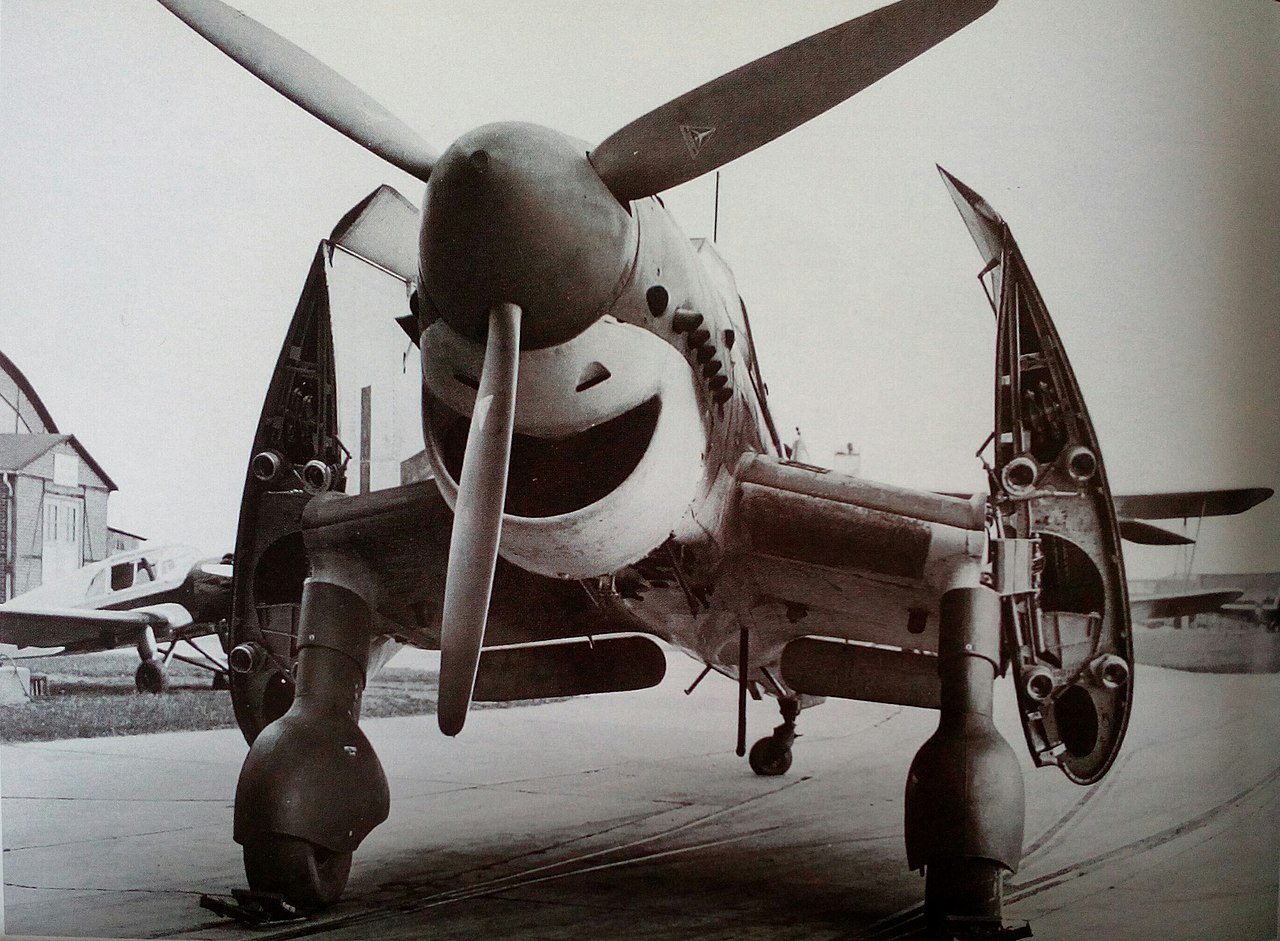
A Ju 87C showing its folding wings
Nor was dive-bombing limited to naval aircraft. The US Army Air Force procured versions of the SBD and SB2C naval dive-bombers, as well as the A-36, a version of the P-51 Mustang fitted with dive brakes and intended to keep the North American production line running because they had exhausted their funds for fighters, but had money left over for attack aircraft. But the most famous ground-attack dive bomber came out of Germany in the form of the Ju 87 Stuka. Known for its distinctive siren, which became almost synonymous with the Blitzkrieg, the Ju 87 was fitted with a unique automatic dive system. The pilot would set intended drop altitude on his altimeter and open the dive brakes, which would automatically nose the airplane over, and he would then select his dive angle using a series of marks painted in the cockpit, which would be aligned with the horizon. At the appropriate altitude (at least 1500' above the ground, if the pilot wanted to survive), a light would come on, and a single button would drop the bomb and pull the plane out of the dive, even if the pilot was incapacitated by the 6G pullout. Besides its use against land targets, the Germans also used the Ju 87 against ships, even planning to make a modified version, the Ju 87C, the primary strike aircraft of their carrier, Graf Zeppelin, where it would serve as both dive and torpedo bomber.1 But in a rare moment of sense, the Germans realized at the outbreak of the war that although she was 85% complete, Graf Zeppelin wouldn't be of much use, and called off the whole program. The Stuka did see service against ships in the Mediterranean, most notably badly damaging Illustrious in early 1941 despite her armored deck and later driving the Royal Navy from the seas around Crete. But these were only possible because the British lacked good fighter cover, as German attempts to use Ju 87s over Britain the previous year had shown that the aircraft was too slow and vulnerable in the face of serious opposition, and Germany didn't have a viable replacement in the pipeline.
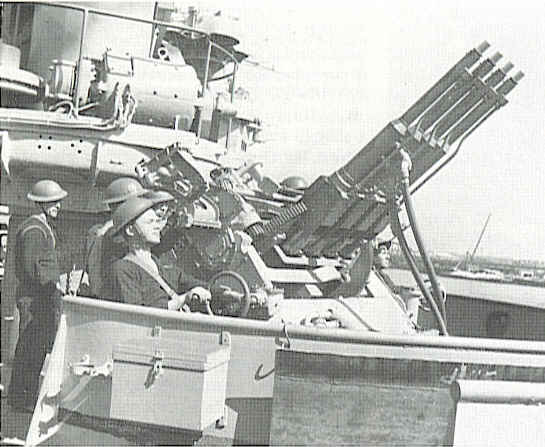
A 1.1" mount, showing the gearing for the slewing mechanism
In operations, the airplane tended to approach either out of the sun, to preserve surprise, or to dive along the ship's line of travel, which would make compensating for the vessel's movement easier, at least so long as the wind wasn't too strong. If it was, then they might dive along the wind, eliminating the crosswind component. But given how quickly the planes dived, it was possible to attack from multiple directions, greatly complicating the work of the defenders.2 When first encountered, dive bombers sometimes almost stunned the crew into insensibility, but repeated exposure soon made it possible to return fire, a particular problem for fleets with multiple ships close together, as it removed the problem of attacking planes nearly directly overhead. This was a serious problem for most light AA guns, as their mounts operated in only two axes, so a plane moving near the zenith might require significant traverse from a small movement. The US attempted to solve this with the unique slewing mechanism on the 1.1" AA gun developed before the war, which would allow the gun to traverse 30° to track dive bombers at high angles. In practice, this wasn't a huge problem and the 1.1" was quickly replaced by the 40mm Bofors.
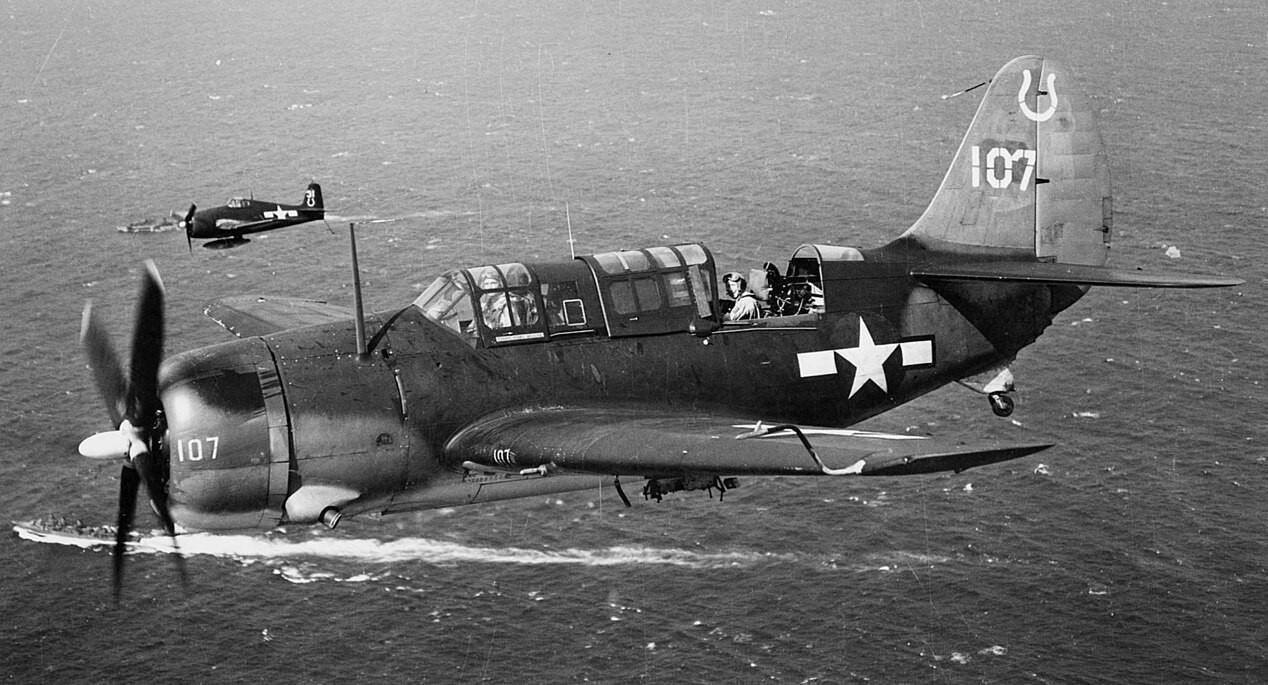
An SB2C3 Helldiver
By the second half of the war, the increasing size and power of airplanes began to erode the distinctions between types. The British built the Fairey Barracuda, intended as a combined dive and torpedo bomber, although in practice it served mostly as a dive bomber before being replaced by lend-leased Avengers, while the SB2C Helldiver, the replacement for the SBD Dauntless, was equipped to carry torpedoes, although this was never used operationally. Its replacement, the AD Skyraider, was designed as a fusion design to fully take over both functions, and went on to become the last piston-engine combat aircraft in US service. But as dive bombers expanded into torpedo bombing, bigger fighters like the Hellcat and Corsair entered service with the ability to haul bomb loads equivalent to early-war dive bombers. And while they may have lacked the dive brakes required for a really steep diving attack, they were able to use somewhat shallower dives to hit targets with similar accuracy.4 Even torpedo bombers began to get in on the glide-bombing trend, and by the early 50s, air wings were expected to be a mix of fighter-bombers and attack aircraft capable of employing both bombs and torpedoes.
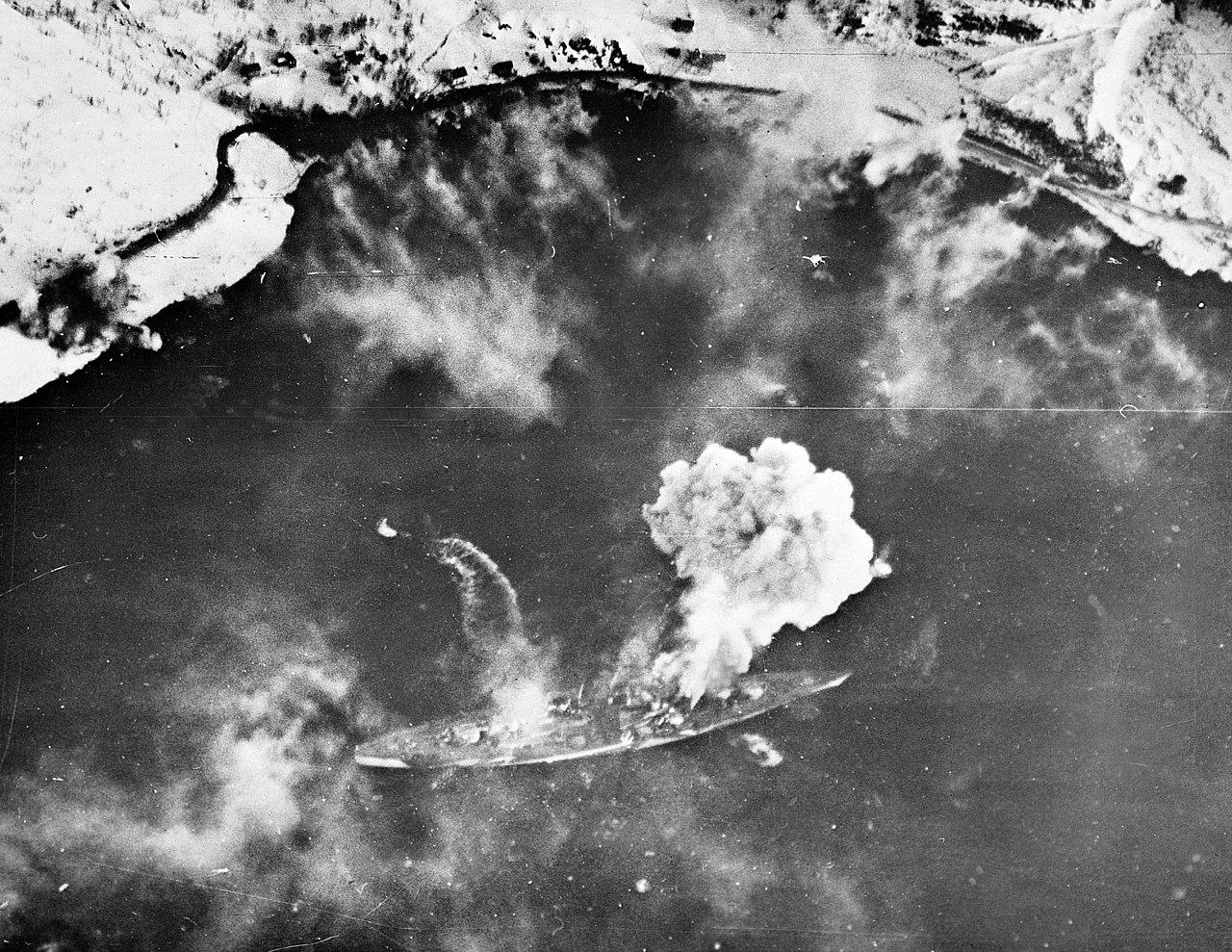
Dive bombers attack Tirpitz
In operation, dive bombers made their most famous contribution at Midway, when American Dauntlesses smashed the Kido Butai, but dive and glide bombing was the predominant method of sinking ships from aircraft from the start of the war to the very end. British dive bombers claimed the German cruiser Konigsberg off Norway in 1940, the first major warship sunk by air attack, and in the closing days of the war, the American attacks on Kure that sank what was left of the Japanese navy were conducted entirely using bombs. Victims included battleships Ise, Hyuga and Haruna, all struck by multiple bombs and badly holed below the waterline. Also heavily attacked by dive bombers was Tirpitz, during Operation Tungsten, although most of the British pilots released their bombs too low, leaving them with insufficient velocity to penetrate the German battleship's deck, allowing her to survive despite 15 hits. A follow-on, Operation Goodwood, was largely thwarted by bad weather and German smoke generators. Only one large bomb hit Tirpitz, and it failed to go off. Dive bombers also participated in the attacks on Yamato and Musashi, where they didn't do the main job of letting water in, a task that fell to torpedoes. Instead, they were valuable in destroying AA guns and generally disrupting operations onboard the battleships, while near-misses caused minor flooding and may have weakened the TDS, increasing the effectiveness of the torpedo hits.
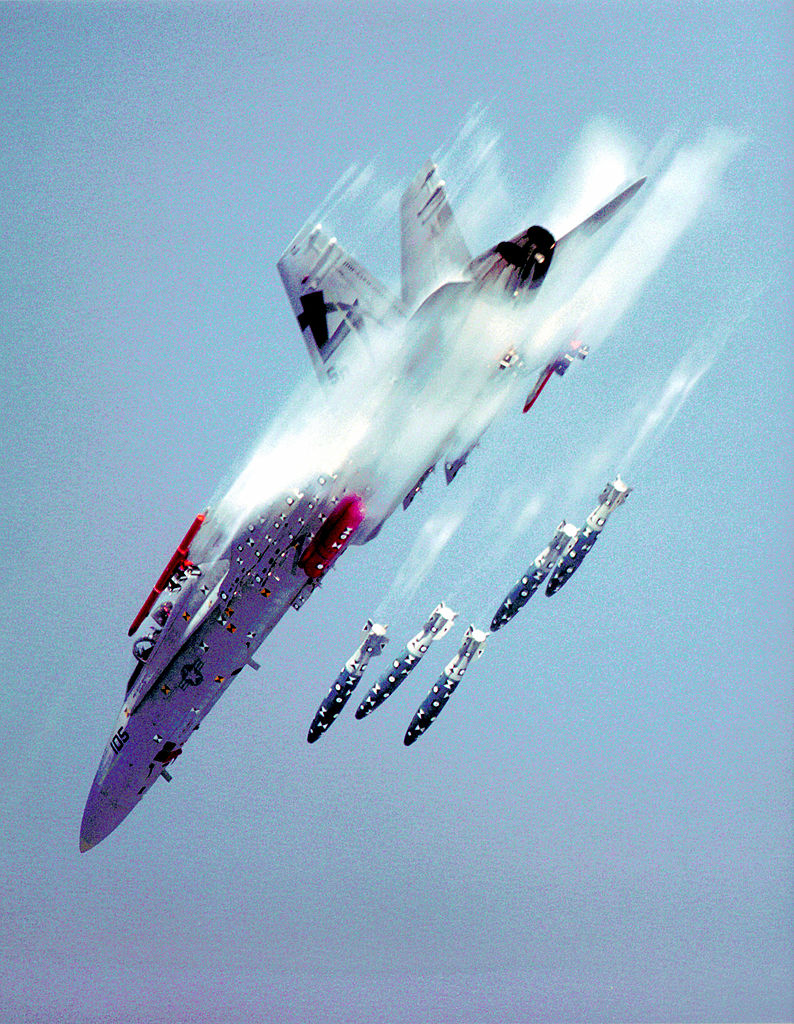
A Hornet releases bombs in a dive
Postwar, the true dive bomber died off fairly quickly, as it was vulnerable to both fighters (much less of a problem in the days before radar) and to the much larger batteries of AA weapons that sprouted from warships at the end of the war. Instead, tactical aircraft (whether they be fighters or dedicated attack aircraft) generally expected to deliver their bombs in a shallow dive, which reduced their exposure to defenses and didn't force them to slow down over the target the way dive bombing did. This technique remained common up through the 90s, when the introduction of cheap smart bombs rendered unguided bombing pretty much obsolete.5 But in its heyday, dive bombing was the most effective way to deliver explosives to ships, at least ones less well-armored than a battleship.
1 The Stuka apparently had the payload for this, as it was fitted with a heavy (771 kg) bomb later in the war. ⇑
2 Japanese tactics, which I have the most detail on, would have probably involved three groups attacking about 30° from each other. ⇑
3 This means "Second Curtiss Scout Bomber", but the obvious suggestion of "Son of Bitch 2nd Class" was a frequent nickname for this rather unpopular aircraft. ⇑
4 Well, probably. I have reports of Corsairs diving at 85°. This whole thing is very confused. ⇑

Comments
If my memories are correct (never a given), the Falcon 3 flight sim gave the F-16 a "bombing mode" setting in the HUD, which, if not 'true' dive bombing, would still guide the plane into a pretty steep dive to place ordnance on target
Two things. One, while the Germans explored hanging torpedoes under the Ju 87C, and the aircraft certainly had the payload capacity, AFAIK the planned torpedo bomber for Graf Zeppelin was the Fi 167. When GZ's planned air group ditched the Fi 167s in 1942, it also ditched the torpedo attack mission.
Two, Vought seems to have anticipated the F4U being used for ground attack. The aircraft was apparently built with a setting to partially extend the main landing gear in order to use them as dive brakes. I don't know how commonly this was actually used, but it would lend credence to the reports of Corsairs carrying out steep diving attacks.
Pretty sure the landing gear on the F6F Hellcat could double as speed brakes as well. It would seem some Divebombing capacity was factored into both the Corsair and Hellcat
Turned out you could sink a battleship with a Stuka.
https://www.warhistoryonline.com/featured/the-day-that-stuka-pilot-hans-ulrich-rudel-sank-the-soviet-battleship-mara.html
Yes, I was aware of that, but chose not to include it because the ship was (a) extremely old and (b) anchored in Leningrad harbor.